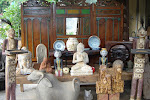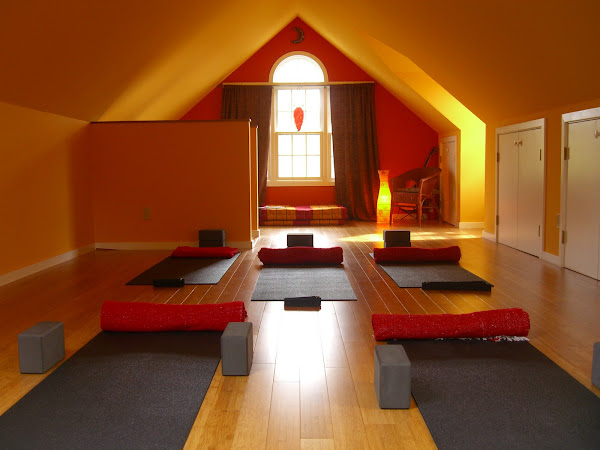

Did you know that 50 to 80% of the adult population will experience back pain at some point in their life? 40% of us have back pain in any one year. Back pain is one of the most common causes of disability in the working population.
I am taking a physical therapy continuing education course right now, called Mechanical Diagnosis and Therapy, and I have just learned that on average we flex our spines (you are not going to believe this!) one thousand times a day. ONE THOUSAND! Every time you lean forward, pick something up, sit down, get up, wash your hands, grab some milk from the fridge, put a dish in the dish washer, slide a mop across the floor...you are flexing. Life is flexion!
Well this is not good news really, because the predominant source of all back pain is disc bulging or herniation, and 98% of the time, the culprit is flexion. Are you sitting right now? Are you sitting slouched? That's flexion.

(Here you can see the dark blue nucleus at the center of the disc, migrating towards the back of the spine - it is being squeezed like the jelly in the middle of a doughnut - it is bulging - as a result of flexing the spine - a lot.)
On day one of this physical therapy course, the instructor said something that did not leave me for three days. He said that back pain is normal.
Back pain is normal.
Well that was such a strange statement to me, and so, I have to confess, I have never thought of pain as normal. I thought of it more as a mistake, I suppose, the result of an accidental occurrence, the consequence of injury. I just never thought of it as normal. But I do like this thought. It feels very familiar to me.
The first principle of Buddhism is that life is suffering. Now there's a thought that tends to make a lot of folks a tad bit ticked off. And boy oh boy, the Buddhist principles get worse before they get better, because the second principle is that we actually create our own suffering. Thankfully, the third one says we can prevent future suffering, and the fourth one explains how. There is light at the end of the tunnel.
Well today, I am as curious about pain, as I am about suffering, and I have been pondering the possibility that we create pain or escalate it, by losing touch with the present moment - but also how natural a thing that really is to do (given that we flex ONE THOUSAND times a day!), and what a wealth of information there is to learn from the experience of this. Mostly, though, I am thinking about slouching.
The lessons of flexion have been magnified for me these past three days. Well, for one thing, I have been sitting for 8 hours a day in class. And for another thing, I have been driving 2 and 1/2 hours twice a day in order to attend this class. That's 39 hours of sitting so far and one day to go. I HAVE BEEN SITTING A LOT. I am really having to work with this posture.
I shift around endlessly. I sit on my right hip, sit on my left hip, the front of my sit bones, cross-legged, resting on one shin, then the other, drawing one knee up toward my chest, reclining...and all the while I keep playing with this lumbar roll I received at the beginning of the course, sliding it into the many spaces between me and my chair, so that I can feel supported. I can't stop moving! During the breaks, I get up and begin stretching everything I can into extension, the opposite of flexion. I stopped short of urdhva dhanurasana (full wheel), but tomorrow I'm determined to incorporate that one as well, no matter what the other students think : ) because I definitely do so want my juicy discs resting joyously in the center of my spine.
Now, as a yogi and a physical therapist, I happen to know a lot about posture. I know that when my skeleton is aligned, the least amount of effort is required of my muscles. To center my bones creates ease. I also believe that to be mindful of the details of my anatomy keeps me awake and present. So today, somewhere between slouching this way and that, I decided to interrupt my incessant three day wiggle to find neutral spine, with all of its natural curves, especially the curve of my lumbar region.
I slid forward in my seat, got my feet to the ground, rooted my sit bones into the chair, and climbed up from there like a tree reaching its leaves into the sun. There is some wakeful energy required for this, and I wonder why we tend to think of that as such a chore? Why do we resist it? Or why do we often not even give it a thought?
I sat with sitting. For one full hour, I sat with unsupported, anatomically aligned sitting. Every time I began to move towards a new posture, I caught myself, in the same fashion as I catch my thoughts during meditation and come back to my breath. Nonjudgementally, I noticed my exit from aligned sitting and realigned. Then I got real curious about why I wanted to exit in the first place. Was I uncomfortable? No. Not physically...
Movement is as natural as thinking, and so it is not my intention to disparage either. I happen to love my thinking brain, and I love my moving body. What I find fascinating, however, is the habits of thought and the habits of posture. Watching my thoughts teaches me more than thinking them! : ) And today, watching the habits of my posture taught me a great deal as well. I learned how really difficult it is for me to stay.
I practiced staying. I could almost here Pema Chodron whispering in my ear, quietly nudging me with her gentle voice to "stay". I noticed the quality of my mind when I stayed. Do you know what the anatomical experience reminded me of? Emptiness. That quality of the meditative experience that occurs when the story lines disappear and the mind settles. With my spine aligned, my muscles quiet, and all of my connective tissue balanced three-dimentionally, there was a sense of stillness, lightness, spaciousness...and emptiness. Do you know what I think is uncomfortable about emptiness for me? There is nothing to hold on to.
Do we move and fidget and lean and grasp with the various parts of our body, reaching out for support, crutches, ground...to avoid the emptiness of staying? When both the fidgeting of our muscles and our thoughts settle down, what is it that causes us to take off again. What is it about the present moment that causes us to run. Why is it so hard to place our trust in the immediacy of our experience. And in the example of posture, isn't it interesting to learn how hard it is to break from the comfort of habits, like a good old lazy slouch, even when we know that those habits are harmful to us, and that frankly they are not even comfortable, carrying with them the promise of some over-elongated back muscles just screaming to be re-shortened - even when we experience for ourselves that sitting up aligned is physically very comfortable.
I do realize that your experience of sitting up with "good posture" could be completely different. For one thing, you may discover, because of some muscle tightness here and there, that sitting upright is NOT physically comfortable for you. And so then there is the job of working with that and adjusting the muscle lengths of those areas. That's a good project! : ) Learning to align, learning to stay, learning to contact emptiness to see what comes up...these can all be wonderful projects, designed to wake us up, keep us present, and to keep us from escalating both suffering and pain. You could check this out for yourself - to see if this rings true for you.
In any event, please remember to EXTEND your spine today. One thousand flexions is a seriously off balanced situation. The discs of your spine will thank you.

















